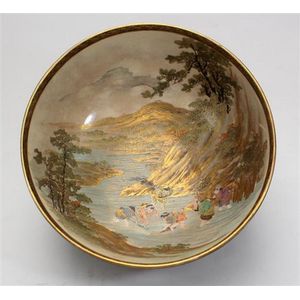German Terracotta Wall Plaque with Children and Village Scene
You must be a subscriber, and be logged in to view price and dealer details.
Subscribe Now to view actual auction price for this item
When you subscribe, you have the option of setting the currency in which to display prices to $Au, $US, $NZ or Stg.
- Terracotta - Terracotta is lightly fired earthenware, red or reddish-brown in colour, used in ancient times. Fired at higher temperatures terracotta was used in the nineteenth century for decorative vases and similar objects, but rarely for utilitarian goods. Other uses for terracotta include roofing tiles, garden pots and ornaments. Glazed terracotta is known as faience.
- Trompe L'oeil - Literally translated from the French, trompe l'oeil means "to deceive or trick the eye" and describes works whose subjects are presented so realistically that the viewer of the artwork or object believe they are looking at a three-dimensional object.
- Oak - Native to Europe and England, oak has been used for joinery, furniture and building since the beginning of the medieval civilisation. It is a pale yellow in colour when freshly cut and darkens with age to a mid brown colour.
Oak as a furniture timber was superceded by walnut in the 17th century, and in the 18th century by mahogany,
Semi-fossilised bog oak is black in colour, and is found in peat bogs where the trees have fallen and been preserved from decay by the bog. It is used for jewellery and small carved trinkets.
Pollard oak is taken from an oak that has been regularly pollarded, that is the upper branches have been removed at the top of the trunk, result that new branches would appear, and over time the top would become ball-like. . When harvested and sawn, the timber displays a continuous surface of knotty circles. The timber was scarce and expensive and was used in more expensive pieces of furniture in the Regency and Victorian periods. - Circa - A Latin term meaning 'about', often used in the antique trade to give an approximate date for the piece, usually considered to be five years on either side of the circa year. Thus, circa 1900 means the piece was made about 1900, probably between 1895 and 1905. The expression is sometimes abbreviated to c.1900.
This item has been included into following indexes:
Visually similar items

A Japanese Satsuma bowl, with exceptionally fine painting, Meiji period, the interior painted with boys wading through a river & catching fish, the exterior with an old flowering plum blossom and flying plovers, a lacqured mon with clear gilt signature, di

An unusual Chinese Yun glazed circular stoneware basin. 23 cm diameter. Provenance: Private Collection, Italy

Antique 18ct yellow gold and citrine brooch, weight: approx 9.2 grams

Royal Worcester plate painted with Jersey cows, 23 cm diameter
